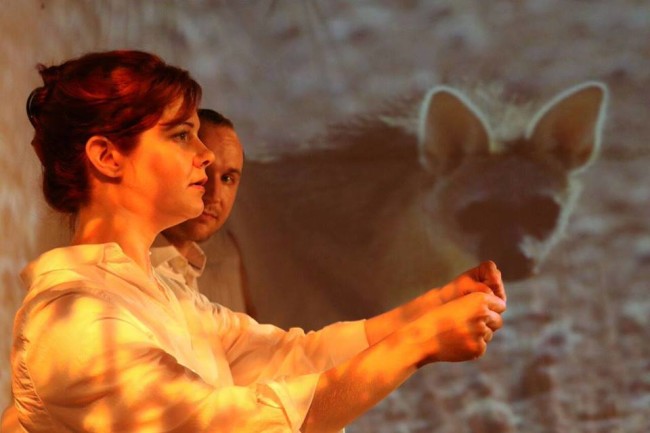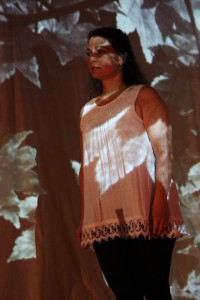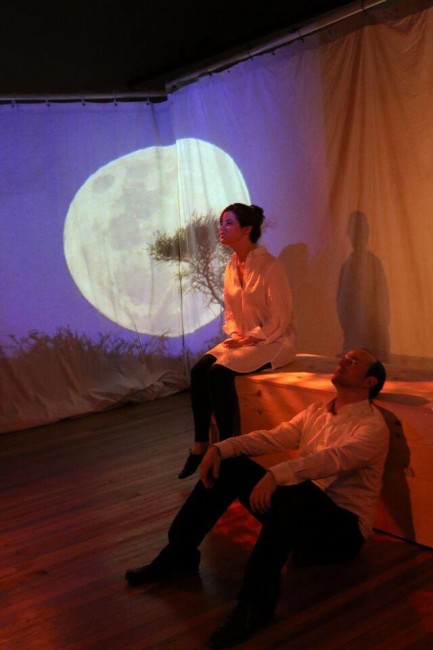Immortality is a faded portrait. Theatre is the art of capturing the ephemeral and transposing it— even just for a moment, an evening, a run of a show— into immortality. In a TheatreBloom exclusive interview, we sit down with area Director Jonas David Grey to discuss his latest directorial work with Cohesion Theatre Company.
If you could give us a quick introduction for the readers that may be new to TheatreBloom or to your work, we’ll get started.
Jonas David Grey: My name is Jonas David Grey, with an ‘e’ in Grey, which you have never misspelled but others do. Since appearing in Chesapeake Shakespeare’s Richard II, I went straight out of that down to The Language Archive at Silver Spring Stage where I wasn’t behind the stage but rather on it in a production directed by Joseph Coracle. Actually, there was overlap between The Language Archive, and my directing The Pillow Book for Cohesion Theatre Company starring Joseph Coracle. He and I were in Richard II together and that’s where that started. I watched him every night in Richard and at that point The Pillow Book was already on my radar. It all just fell into place from there.
How did The Pillow Book get onto your radar? This is only the second production it has received.
Jonas: Well, Cohesion Theatre sort of grew out of the elicit professional union of Alicia Stanley and Brad Norris. He works at Centerstage and she worked at Chesapeake Shakespeare, but the analogy that I would like to make is that there was this big fluffy bed called Edward II and they got in it together and they had a baby. And the baby became Cohesion. They hit it off and here we are. I pulled Alicia into Edward because what I needed to happen in that production was not fair to dump on just one director, so I asked her to assistant direct. She and Brad met, I have no idea how the Cohesion thing even came up in their heads, but they just announced at the Edward II cast party that they were starting a theatre company. Here we are, a year and a half later.
Congratulations to you and many of those people you just mentioned as a part of Edward II, I believe they took home quite a few awards at Baltimore Awards ceremony over the holidays.
Jonas: Yes, they did! Brad and Alicia were awarded Best Director, the show received the award for overall Best Show, and our Lighting Designer received the Best Lighting Design award all at The Bad Oracle’s Bulshit Awards. I received Best Actor in a play from Broadway World’s awards. It was very gratifying all around. It’s funny because shortly after that Brad and Alicia approached me about directing.
This is how you came to be involved with The Pillow Book?
Jonas: Yeah. Brad and Alicia came to me and said “would you direct this play?” and I said, “Yes.” And they said, “Good. We’ll send it to you.” I agreed blindly. I had no idea what it was. And then I read it. The play is non-linear as it’s written. Playwright Anna Moench has given the actors, directors, and technical staff a scene breakdown of the characters and the relationships and how they play out, and a list of all the scenes numbered in their chronological order. I didn’t get that. I just got Prologue through to Scene 31. I had the names, Deb, Deborah, and John, and that was it. I had no idea what it was about, I had no idea what was going, I thought I was missing pages! I also had a script that wasn’t page-numbered.

I emailed Brad and said “Is this a joke? What’s going on? Am I missing pages? There’s some pretty stuff going on in this play, but I don’t get it.” And Brad said, “Let me send you a page-numbered script, and the breakdown from the playwright.” As it turns out, I had some pages out of order. Once I read her breakdown, I fell in love with it. Actually, I fell in love with it over time. There was a brief courtship with this play. What I fell in love with immediately, much like the way people fall in love generally where there’s just that thing that you become fixated on or infatuated over; there were moments that I just thought were gorgeous. As I got to know the play and studied it and read it over and over again, mining it for what I thought it would be, it grew on me. I think I was still discovering and loving it right up until we opened on Thursday night. We were still evolving until we actually had to open.
What is it about this play that really speaks to you and made you want to tackle it?
Jonas: I had never directed anything like this before. So there was that challenge. The fact that it was three actors and no more seemed like a really nice and easy way to dive into text and subtext. It presented a great opportunity to really mine character and relationships. The relationships that I saw on the page are the ones that really stuck with me. Those beautiful moments that I mentioned, everyone has one of those. Everyone has a gorgeous poetic moment by themselves on stage that’s filled with raw emotion. That’s what I loved about it.
Can you talk a little bit about the conceptualization that you’ve put forward in this show? The nontraditional setting of the show and other things you’ve developed for it, where it comes from and how that translates to what we’re seeing on the stage?
Jonas: I started with the idea that if we were going to do this play we had to go out of our way to make it easy on the audience. I don’t mind audiences not liking something. I don’t mind audiences not completely getting something. I refuse to cater to the lowest common denominator and say “oh here’s A, B, C,” as far as a story goes. But I look at a script like this and recognize that as artists we have a responsibility to touch our audience, which means in this case we’ve got to help them as much as possible. My two primary goals for this were to not change a single word of text, and to help the audience understand as much as they are capable of understanding in what they see so that they don’t walk out just angry. I don’t like those sort of avant garde theatre pieces that are just there to provoke. They do have a place and they do have a purpose but that’s not what I want to direct. I don’t feel like this is a provocative show in that respect. I feel like it’s innovative and it’s challenging. And it’s absolutely evocative.
Where the set design was concerned, Alicia came to me early on with this idea of looking to the sculptures of Louise Bourgeois as a starting point. Many of Bourgeois’ works are installations inside cages. Alicia showed me a couple of pictures and one of them was a big spider with a chair inside of it. I thought it was an interesting way to go, and it evolved from there. Once she brought me there, I thought, “okay! Great! We’re going to have a box and it’s going to be made of scrim and we’re going to have the world of the play outside the box and the actors are going to be inside the box.” But then I learned we’re limited. We couldn’t do scrim or the lighting to support what I was going for with that. So we settled on muslin, which to me looks like the stuff that you throw over your furniture at your summer house when you go away for the winter. For the record, I don’t have a summer house.
There are three primary relationships in this play; there are three primary representations in the set, one for each of the relationships. We wanted to build very realistic settings for those characters. Well, Alicia did. But I didn’t want those settings accessible to the audience during the context of the play. The play is a lot about memory. My take on this is that a single event can absolutely eradicate and forever alter the course of someone’s life. And that that is what happens in this play. I have a very clear idea of what’s going on and I’m not telling anybody my very clear idea. Other people have very clear ideas of what they think is happening and those ideas are no less right or wrong than mine. That’s one of the great things about this play. But I wanted the audience to be able to be outside looking at a realistic space before the show starts. And then we take them inside the box with the actors. At that point all they have is their memory and some faded silhouettes that we backlight at appropriate moments. That is how the set evolved.
You mentioned working with Joseph before, and that’s how you got him involved, but how did you get Rebecca Ellis and Michele Massa involved?

Jonas: I know Michele personally. And just from knowing her and listening to people talk about some of the things they had seen her do a long, long time ago, I liked her energy. Between that and her resume I knew that she was capable of acting through the part. Truth be told, and I’m okay that this is public now, but I was dead set on Joseph, and if I could get Michele to agree to it, I wanted her. I didn’t have the third actor in place. I wasn’t sure who that was going to be. There were a couple of friends of mine that had expressed interest, Brad had introduced some people, and there were other people who were curious. But it became clear very early on in the auditions that Rebecca was the perfect fit for the character. I pretty much had my mind made up after seeing her. I don’t even think we really did callbacks. It’s a very lucky thing for a director to be able to get exactly what they want in regards to vision when it comes to their actors. I auditioned some super talented people, who if I told you their names, you’d be saying “oh my gosh, yes they’re great!” But I think the picture just fit perfectly with the three I have. They are fantastic, I adore them, and I can’t say enough about them.
You mentioned the challenge of the nonlinearity of the show, and the space issues, but have there been other challenges for you in directing this show?
Jonas: This has been so much not a challenge generally speaking. Some of that I think is my own personal evolution. A friend of mine recently turned me on to a book called Why Zebras Don’t Get Ulcers, and I’ve been learning how to not stress the way zebras do. I’ve been able to let things be. I wanted a big scrim box. We couldn’t have that, and I just said “okay.” Everyone’s really worked well together. So the real challenge has been with the script. With a script like this, how do you take it to actors and then take it into rehearsal? I spent a week just color coding the script. There are three major relationships and each of those relationships have their own color. And then there are three page numbers on the page. The author’s page number, our working page number, and the chronological page number— meaning the order in which the scene would have happened if it were linear.
We rehearsed for a week and a half just with table work in chronological order. And then we took a break after we’d established those relationships and we came back and started rehearsing the show in the order that the playwright wrote it, from beginning to end. It’s a short show so basically every night we ran the show. Then I would spend an hour or two working on little moments. But they’ve been wonderful.
With a show like this, it runs the danger of angering or chasing away audiences. So what is it that you think they will take away from it when they see it?
Jonas: I hope they feel something. The best theatre to me is theatre that brings stuff up inside us. The best shows that I’ve seen are shows that make me feel and make me think. That’s the human element of the stage. That’s the connection. I know plenty of actors who would just love to perform just for the sake of performing and don’t need an audience. But the reason we put it in front of an audience is to make that connection. Same thing happens in rock concerts and operas. It’s the idea that something emotional will be stirred inside of us. That’s what I hope happens here. I don’t see how it could not happen with this play.
What I love about it is that we will have five people sitting side by side and they will have five different things resonate with them. There is something deeply personal, be it the loss of something close to us, or a childhood trauma, or an adulthood trauma, being in a relationship and wanting different things, or that day where you realize you’re not on the same page— all of those things will connect in one way or another with the individuals in the audience in different ways.
What has taking on this project taught you about yourself?
Jonas: This is years of therapy wrapped up in this experience, but it’s taught me that I’m not as uptight as I used to be. So that’s a good thing. That may be in part because everyone’s been so easy to work with. There have been no tantrums or backstage dramas. I have a very small cast and we’ve all spent a lot of time in small rooms just working, working, working. We’re all here because we love this project and we all want it to be the best possible thing it can be. So it has been easy in that respect. It’s reignited the passion in me in regards to directing. I’ve been very fortunate to have played some incredible roles recently, but this has re-inspired me to go back to directing. I’d like to do that for a while now.
Why do you think it’s important for a company like Cohesion to take a chance on a work like this?
Jonas: There are a couple of reasons its important. First of all, part of Cohesion’s mission is to get out there and do stuff that isn’t getting done otherwise. Right now they have this huge passion for female playwrights. They pulled this play from the Killjoy submission of 2014 and then they ask a man to direct it. But I’ve lived with it for so long that it seems to me that it was just written by a playwright. If you put a different gendered name on this, I don’t think anybody would be shocked or surprised, and I mean that in a good way.

Secondly I think that smaller theatres need to be a little more daring and gutsy. They need to be a little squeakier to get noticed. I think this has rounded out their season beautifully. All three of their works are vastly different from each other. It speaks to what they have to offer by way of versatility and creativity. And again, if you’re doing work like this with the idea that you’re going to be touching people’s lives— not necessarily changing anybody’s life— but people are going to walk out feeling something. Any time you can make people feel honestly it’s a good thing.
Why should people come and see The Pillow Book?
Jonas: I think it’s one of the most interesting shows that I’ve encountered in Baltimore in a very long time. It’s atypical on so many levels. It’s nonlinear, it’s abstract in places, it’s poetic, it’s beautiful. There are relationships to be mined in it; it’s a puzzle. I don’t think people should just see it. I think people should see it multiple times because I think the more you look at the play on the stage and think about it and talk about it, the more you’re going to understand about the human condition. It’s a short beautiful piece that I’m very proud of. It’s literally beautiful. It’s pretty to look at. When I was a child, the family would gather every so often to look at slides my dad projected on sheet he hung in the family room. That’s how we viewed our memories. That’s probably the basis for my choice to use projections here. I wanted the projections to be realistic. I picked every one of those images. There’s only one image that’s abstract to the nth degree. There are two more that are representationally abstract, but everything else is realistic. Not only are we projecting these images onto the muslin but we’re projecting these images onto the actors who are wearing white tops and that creates a beautiful image in itself. This play is all about memory and how it affects us and that becomes a part of it.
Anything else you’d like to say about the experience?
Jonas: I could talk forever about this because it’s been such a good experience. I can’t say enough about these wonderful actors. I want people to see it, to see them and to see what they do. None of these people are actors that a lot of people know. They’re not Baltimore actors for the most part or if they are, they’re underground. They’re very exciting, they’re very vital. Michele Massa brings such an understated reality to the performance it’s stunning. Her energy and that almost film-realism that she brings to it, juxtaposed against Rebecca’s mastery of just being bigger, with poor Joseph caught in the middle juggling them both. He probably has the hardest job because he has to change characters so much. I think these actors deserve to be seen. Cohesion is doing great work. They have an amazing year ahead of them. And they play well with others. That is not something I’ve really seen in Baltimore. This idea that a company can say “yeah, come play with us. Yeah we’re share our space and our production and our talent.” That’s gorgeous. People need to see this show to see that that sort of theatre works beautifully in Baltimore.
The Pillow Book plays through July 12, 2015 at Cohesion Theatre Company in conjunction with Strand Theatre currently playing at Church on the Square in Canton— 1025 S. Potomac Street in Baltimore, MD. Tickets can be purchased at the door or in advance online.


